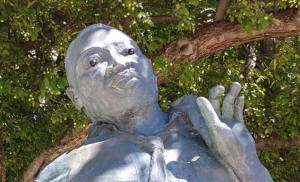State task force considers redesigning, moving monument of MLK Jr.
 Send a link to a friend
Send a link to a friend
[June 10, 2021]
By SARAH MANSUR
Capitol News Illinois
smansur@capitolnewsillinois.com
 SPRINGFIELD — Members of the state’s task
force on statues and monuments discussed ways to relocate the statue of
civil rights leader Dr. Martin Luther King Jr. and improve the statue’s
image in the context of King’s legacy in Illinois. SPRINGFIELD — Members of the state’s task
force on statues and monuments discussed ways to relocate the statue of
civil rights leader Dr. Martin Luther King Jr. and improve the statue’s
image in the context of King’s legacy in Illinois.
Illinois Secretary of State Jesse White testified Wednesday during the
task force hearing that the image of King reflected in the statue does
not properly reflect one of the heroes of the civil rights movement.
White met King dozens of times, including while White was a student at
Alabama State University.
“It’s our duty to make sure that the statue properly reflects Dr. King's
creation. And as I have said before, I am willing to devote $5,000 of my
funds if we can get enough dollars, so that we can make a statue that
will be a true representative of Dr. King,” White said Wednesday.

White said he intends to establish a fund for the purpose of redesigning
King’s likeness and moving the sculpture from its current location
across from the Capitol grounds.
The hearing Wednesday was the third meeting of the House Statue and
Monument Review Task Force, which aims to conduct a review of monuments
on state property and proposals for new monuments or statues.
Discussions about relocating and redesigning the King statue are not
new.
In August, the board members of the Office of the Architect of the
Capitol considered moving and remaking the statue, which sits at the
corner of Second Street and Capitol Avenue in front of the Illinois
State Library.
Last month, White committed $5,000 to a new King statue in a more
prominent location.
The 300-pound bronze statue of King was made by Geraldine McCullough, an
African American sculptor born in 1917 who studied at the School of the
Art Institute of Chicago.
The statue was first unveiled in 1988 in the state Capitol Rotunda, then
moved outside of the Illinois State Museum in 1989.
It was moved to its current location and rededicated in 1993.
Task force chairperson Rep. Mary Flowers, a Chicago Democrat, and
minority spokesperson Rep. Tim Butler, a Springfield Republican, both
agreed that King’s likeness could be improved.
“That statue does not reflect the man that I met on 70th (Street) and
Lowe (Street) in Chicago when I was maybe in second or third grade,”
Flowers said. “You have to imagine when our kids or when people come up
to see Martin Luther King, who did not have the privilege, like you and
I had, to see him in person, they think that that's what represents him,
or that's the likeness of him, and none of that is true.”
Flowers asked White about his vision for the statue, and what he would
like to see written on the statue or the plaque that will be affixed to
the statue.
White said he was leaving those decisions to the task force.
[to top of second column]
|

A statue of Martin Luther King Jr. is pictured across
the street from the Illinois State Capitol. Secretary of State Jesse
White testified before a statue review committee Wednesday that he
would like to see a new statue of King placed in a more prominent
position on Capitol grounds. (Capitol News Illinois file photo be
Jerry Nowicki)

“But the bottom line is just I want to make sure we
find a good artist, and make sure that he will not only take the job
but take on the responsibility that goes with it,” White said.
Butler proposed erecting a statue of King at the Illinois Armory
Building, where he gave a speech to commemorate the Illinois State
AFL-CIO’s 8th annual convention on Oct. 7, 1965.
Last year, former Sen. Andy Manar, a Bunker Hill Democrat, filed a
resolution calling for a bronze plaque to be placed at the site of
the historic address to memorialize King’s visit to Springfield. The
resolution never came up for a vote.
Dr. Noelle Trent, director of interpretation, collections, and
education at the National Civil Rights Museum, said King came to
Chicago in 1965 and 1966 to work with community activists —
including a young Rev. Jesse Jackson — on “nonviolent campaigns to
address issues of segregation and inequity throughout the city,
particularly as it pertains to housing.”
King moved with his family to Chicago, where he and the Southern
Christian Leadership Council — an African American civil rights
group that formed out of the Montgomery bus boycott — started the
Chicago Freedom Movement, which was focused on combatting racist
housing practices.
Trent said a violent confrontation took place on Aug. 5, 1966, when
King and other Black demonstrators were marching through an
all-white neighborhood in Chicago.
“They were met with hostility and objects were thrown at them. Dr.
King is actually hit in the head with a rock,” Trent said.

“But these challenges are no different from the other challenges and
obstacles that the movement encountered in other cities.”
Trent said the National Civil Rights Museum is willing to
collaborate with the task force and the Illinois State Museum to
provide resources and other assistance.
“Illinois has this tremendous history of creating social change that
I think could really be expounded using the statue, as well as the
(Illinois) State Museum,” she said.
Capitol News Illinois is a nonprofit, nonpartisan
news service covering state government and distributed to more than
400 newspapers statewide. It is funded primarily by the Illinois
Press Foundation and the Robert R. McCormick Foundation. |